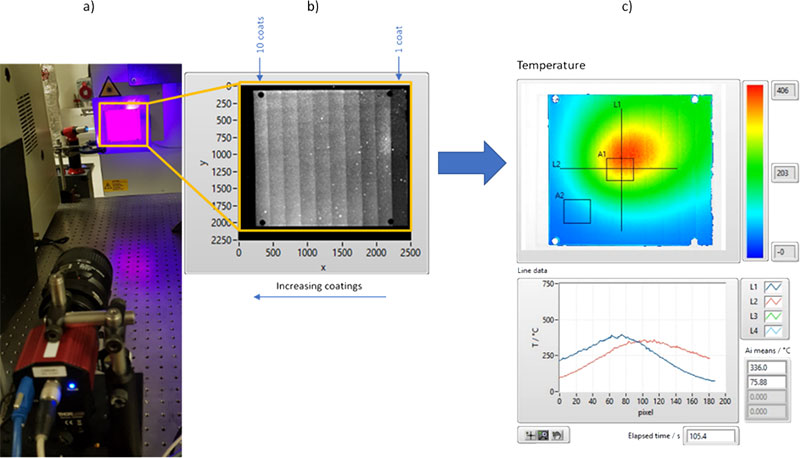NPL has developed a range of capabilities to support the implementation of phosphor thermometry to solve an array of temperature measurement challenges where more traditional techniques are not suitable.
Accurate, traceable temperature measurements are critical in many industrial processes particularly at elevated temperatures. For example, successful thermal processing of metals during forging and forming processes is critically dependent on process temperature. Traditionally, surface temperatures are determined by infrared thermometry (spot pyrometers or thermal images) or sprung-loaded thermocouples. However, it is known that these approaches can have large uncertainties, due to unknown emissivity and background radiation in the former case and due to variable contact and heat-sink effects in the latter.
Phosphor thermometry is an optical method for surface temperature measurement which exploits the luminescence of a phosphor coating which changes with temperature. It has the potential to overcome the limitations of traditional thermometry techniques and can be independent of the surface emissivity and unperturbed by strong background thermal radiation. Thermographic phosphors exhibit a change in their temporal or spectral luminescence properties during or following excitation with UV or near-UV light. With suitable calibration against the International Temperature scale of 1990 (ITS-90), these properties can be related traceably to temperature.

Phosphor thermal imaging of a phosphor multi-coated steel plate, flame heated from the rear: a) intensity ratio camera system observing the plate, b) the raw luminescence emission showing the variability with number of coatings and c) the phosphor thermal image during heating showing independence of coating thickness on recovered temperature
NPL has developed single point and imaging thermometers based on the two most common phosphor thermometry techniques: decay time and intensity ratio.
Decay time: The phosphor is excited with UV/blue light, and when the excitation is switched off, the luminescence intensity decays exponentially. The decay time decreases with increasing temperature, and through suitable calibration, its relationship with temperature can be established.
Intensity ratio: The phosphor is excited continuously with UV/blue light, and the luminescence intensity measured simultaneously in two narrow wavelength bands. The intensity ratio of the two bands versus temperature is then established through suitable calibration.

Principle of the two most common phosphor thermometry techniques. Decay time thermometry shown on the left and Intensity ratio thermometry shown on the right.
Using these techniques, NPL can measure temperatures over the range from -196 °C up to 750 °C, with an uncertainty of less than 1 °C up to 500 °C and 4 °C up to 750 °C, with the potential to measure up to 1200 °C in the future.
Although the technique has been established for over 50 years, the ability to traceably calibrate systems based on the technique can be challenging. NPL has the capability to support that process and provide confidence in measurement data generated.
NPL has supported the development and implementation of phosphor thermometry to solve problems in a range of industrial applications including:
NPL can provide a range of bespoke consultancy solutions to help develop phosphor thermometry techniques and implement measurement best-practise and provide traceable calibration. Please contact us for more information on how to access these services.
Find out more about research in this area.
Research - Reliable harsh environment thermometry
Improving welding quality for submarine assembly
Our research and measurement solutions support innovation and product development. We work with companies to deliver business advantage and commercial success.
Contact our Customer Services team on +44 20 8943 7070